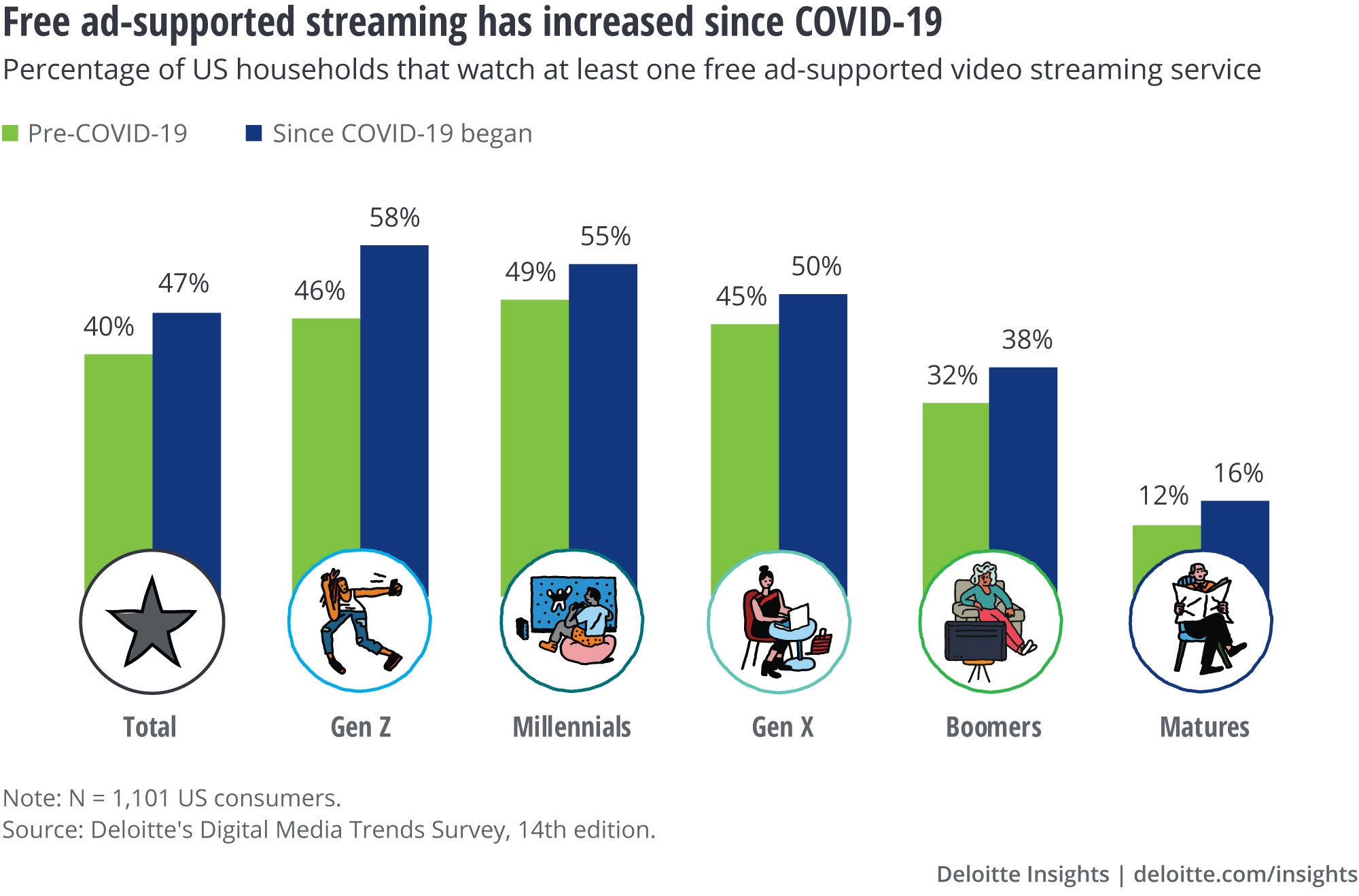Increasingly, video streaming doesn’t mean ad-free
US consumers are turning to ad-supported streaming services to stretch their entertainment dollar

In the United States, there are more than 300 streaming-video services that allow viewers to pay a subscription to watch TV shows and movies without having to see ads.1 Eighty percent of US households now pay for at least one of them; the average subscriber has four.2
But another business model has been gaining momentum among US consumers: free streaming video services that viewers can watch without a subscription. It costs them only the time it takes to watch ads—a familiar tradeoff for anyone who grew up in an era before cable TV.
According to Deloitte’s Digital media trends survey, 14th edition,3 47 percent of American consumers are watching free ad-supported video services such as Pluto TV, Tubi, and the Roku Channel, up from 40 percent before the start of the COVID-19 pandemic.4 That’s 18 percent growth in a matter of weeks.
Unsurprisingly, people most often cite cost—or lack thereof—as the key reason to watch free-ad-supported video. And once consumers start watching, many like what they see. Thirty-seven percent of consumers say they appreciate the broad range of shows and movies available on free services. An equal percentage like the convenience of accessing free ad-supported services on smart TVs and streaming media devices such as Fire TV Sticks, in addition to smartphones and laptops. Unlike with paid services, viewers can start streaming immediately without a credit card and often with no login.
Free streaming services have ad loads that consumers appear to find reasonable. The average consumer says seven minutes of ads per hour is “about right” and that they stop watching a show when the ad load reaches double that.5 Most free ad-supported streaming services hit the sweet spot, ranging from five to eight minutes per hour6—far less than traditional broadcast TV, with hourly ad loads of 14 to 18 minutes.
In short, many consumers see ad-supported TV as a free, high-quality, convenient entertainment option.
Implications for media executives
As budgets tighten, consumers could rely more on free video streaming. Thirty-nine percent of consumers—including 43 percent of free ad-supported viewers—say their household has lost income since the pandemic hit the United States.7 Many cash-strapped consumers have already looked to trim their subscriptions to make ends meet. For example, Gen Z and Millennials have an average of 5 streaming video subscriptions—and a third are worried about making upcoming payments.8 Free ad-supported services are unlikely to replace paid services altogether, but viewers may rely on them more if times get tougher.
Consumers want ad-supported options—and the market may need them. In Deloitte’s latest Digital media trends survey, 65 percent of respondents said they’re comfortable watching ads to eliminate or reduce subscription costs—and that, given a choice, they prefer ad-supported options for watching streaming video services.9 Some services are paying attention: Hulu offers a lower-priced ad-supported option, and over 70 percent of subscribers choose it;10 Comcast, which owns NBC, is launching Peacock in July 2020 with a free ad-supported option.11 Other services may need to launch free and reduced-price ad-supported options to remain viable given the intense competition for subscribers—and dwindling ability to pay.
Free ad-supported video appeals to thrifty Boomers. The main benefits of free-ad-supported video—cost, content, and convenience—appeal to Boomers more than to any other generation. Boomers grew up on traditional broadcast and pay TV, and they’re comfortable trading their time and attention for entertainment. Free ad-supported services could get those who haven’t started streaming off the sidelines.